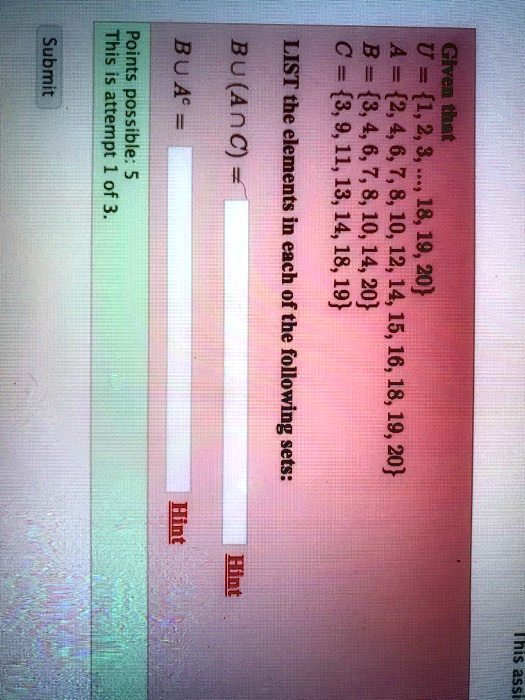Given that U = {1, 2, 3, …, 18, 19, 20} A = {2, 4, 6, 7, 8, 10, 12, 14, 15, 16, 18, 19, 20} B = {3, 4, 6, 7, 8, 10, 14, 20} C = {3, 9, 11, 13, 14, 18, 19} LIST the elements in each of the following sets: B \cup (A \cap C) = B \cup A

The Correct Answer and Explanation is:
Let’s work through this set theory problem step by step using the rules of intersection and union.
We are given:
- Universal set U = {1, 2, 3, …, 20}
- Set A = {2, 4, 6, 7, 8, 10, 12, 14, 15, 16, 18, 19, 20}
- Set B = {3, 4, 6, 7, 8, 10, 14, 20}
- Set C = {3, 9, 11, 13, 14, 18, 19}
Step 1: Find A ∩ C
This is the set of elements that appear in both A and C.
A = {2, 4, 6, 7, 8, 10, 12, 14, 15, 16, 18, 19, 20} C = {3, 9, 11, 13, 14, 18, 19} Common elements: {14, 18, 19}
So A ∩ C = {14, 18, 19}
Step 2: Compute B ∪ (A ∩ C)
Union brings together all elements from both sets without repetition.
B = {3, 4, 6, 7, 8, 10, 14, 20} A ∩ C = {14, 18, 19}
Combining these, we get:
B ∪ (A ∩ C) = {3, 4, 6, 7, 8, 10, 14, 18, 19, 20}
Step 3: Compute B ∪ A
Now we combine sets B and A.
B = {3, 4, 6, 7, 8, 10, 14, 20} A = {2, 4, 6, 7, 8, 10, 12, 14, 15, 16, 18, 19, 20}
Union of both: B ∪ A = {2, 3, 4, 6, 7, 8, 10, 12, 14, 15, 16, 18, 19, 20}
Final Answers
- B ∪ (A ∩ C) = {3, 4, 6, 7, 8, 10, 14, 18, 19, 20}
- B ∪ A = {2, 3, 4, 6, 7, 8, 10, 12, 14, 15, 16, 18, 19, 20}
Explanation
Set theory is a foundational concept in mathematics that deals with the grouping of distinct objects. In this problem, the aim is to determine two derived sets using operations known as intersection and union.
To begin, the intersection A ∩ C includes only those elements that are shared between both A and C. By comparing both, we find that the values 14, 18, and 19 appear in each, so A ∩ C = {14, 18, 19}.
Next, we form the union B ∪ (A ∩ C). This operation merges all values from B and the intersection of A and C, avoiding duplication. Since B already contains 14 and 20, we now add the missing values 18 and 19 to B, resulting in B ∪ (A ∩ C) = {3, 4, 6, 7, 8, 10, 14, 18, 19, 20}.
In contrast, B ∪ A combines all elements from both sets B and A. Even though they have some shared members, we ensure every unique value from each set appears once. This gives us a more comprehensive set: B ∪ A = {2, 3, 4, 6, 7, 8, 10, 12, 14, 15, 16, 18, 19, 20}.
These operations are essential tools not just in mathematics, but also in computer science, data analysis, and logic, where managing collections and finding relationships between them is routine. Understanding how to execute them enhances both conceptual clarity and problem-solving accuracy.
